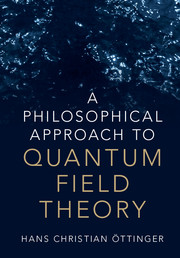Book contents
1 - Approach to Quantum Field Theory
Published online by Cambridge University Press: 21 December 2017
Summary
In this introductory chapter, which actually is the core of the entire book, we make a serious effort to bring together a variety of ideas from philosophy and physics. We first lay the epistemological foundations for our approach to particle physics. These philosophical foundations, combined with tools borrowed from the amazingly sophisticated, but still not entirely satisfactory, mathematical apparatus of present-day quantum field theory and augmented by some new ideas, are then employed to develop a mathematical representation of fundamental particles and their interactions. In this process, also the relation between “fundamental particle physics” and “quantum field theory” is going to be clarified.
This first chapter consists of two voluminous sections: a number of philosophical contemplations followed by a discussion of mathematical and physical elements. The reader might wonder why these massive sections are not presented as two separate chapters. The reason for keeping them together is the desire to emphasize the intimate relation between these two sections: the selection and construction of the mathematical and physical elements is directly based on our philosophical contemplations. The beauty of the entire approach is a fruit of this intimate relationship.
The presentation of the material in this chapter is based on the assumption that the reader has a basic working knowledge of linear algebra and quantum mechanics. If that is not the case, the reader might want to consult the equally entertaining and serious introduction Quantum Mechanics: The Theoretical Minimum by Susskind and Friedman [4]. The book Quantum Mechanics and Experience by Albert [5] offers a fascinating introduction with a strong focus on the measurement problem. An almost equation-free discussion of the history and foundations of quantum mechanics can be found in the book Einstein, Bohr and the Quantum Dilemma: From Quantum Theory to Quantum Information by Whitaker [6]. Complex vector spaces, Hilbert space vectors and density matrices for describing states of quantum systems, bosons and fermions, canonical commutation relations, Heisenberg's uncertainty relation, the Schrodinger and Heisenberg pictures for the time evolution of quantum systems, as well as a basic idea of the measurement process are all referred or alluded to in Section 1.1; these basics of quantum mechanics are recapped only very briefly in Section 1.2. The crucial construct of Fock spaces is explained in a loose way in Section 1.1.3 and later elaborated in full detail in Section 1.2.1.
- Type
- Chapter
- Information
- A Philosophical Approach to Quantum Field Theory , pp. 1 - 109Publisher: Cambridge University PressPrint publication year: 2018



